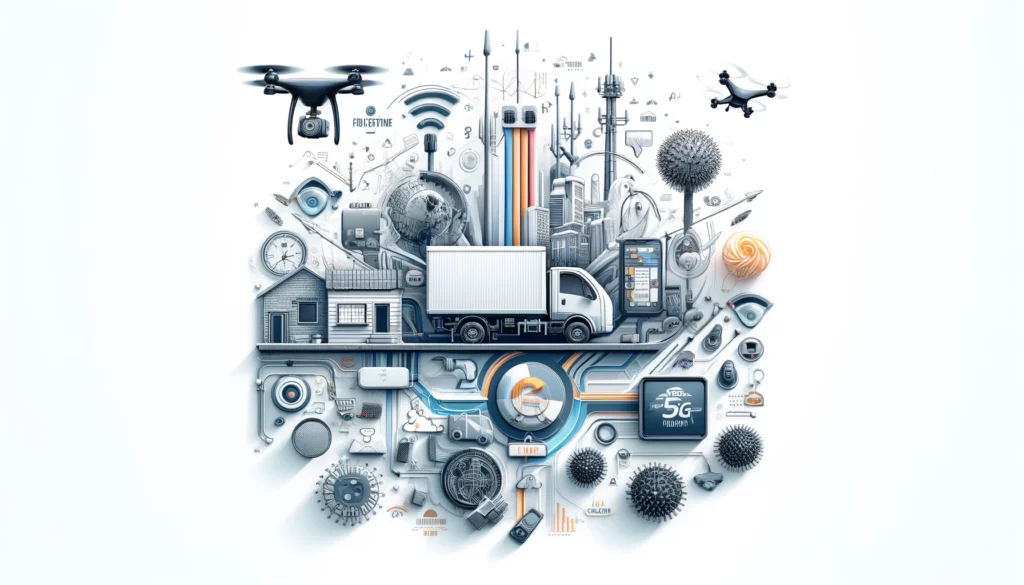
Introduction
Last mile networks refer to the final segment of the supply chain and telecommunications infrastructure that delivers goods or services directly to the end user. In logistics, this involves transporting packages from a distribution center to the customer’s doorstep. In telecommunications, it pertains to the final leg of delivering connectivity from a central node to the consumer’s premises. Last mile networks are crucial for modern logistics and telecommunications, significantly influencing customer satisfaction, business efficiency, and the deployment of advanced technologies such as 5G.
This article will explore the concept of last mile networks, their importance in logistics and telecommunications, the challenges they face, and the technological innovations transforming them. It will also examine the environmental impact of last mile networks and future trends shaping the industry.
What are Last Mile Networks?
Last mile networks encompass the final phase of the delivery process, bridging the gap between central hubs and end users. Historically, these networks evolved from simple courier services to complex logistics systems and advanced telecommunications infrastructure. In logistics, last mile delivery is exemplified by companies like Amazon and DHL, which ensure that products reach customers promptly and efficiently. In telecommunications, last mile connectivity includes fiber optic cables and 5G cells that bring high-speed internet and communication services to homes and businesses.
The scope of last mile networks extends across various sectors, playing a pivotal role in urban logistics, transportation, and connectivity. As consumer expectations for fast and reliable service grow, the efficiency of last mile networks becomes increasingly important.
Importance of Last Mile Networks in Logistics
Last mile logistics is a critical component of the supply chain, directly affecting delivery times, costs, and customer satisfaction. Efficient last mile delivery can enhance the overall customer experience, making it a competitive advantage for businesses. Companies like Amazon and DHL have revolutionized last mile logistics through innovations such as same-day delivery and advanced tracking systems.
Effective last mile logistics can reduce operational costs by optimizing delivery routes and utilizing smart logistics solutions. For instance, Amazon employs sophisticated algorithms to optimize delivery routes and minimize travel time, while DHL leverages real-time tracking to improve delivery accuracy and efficiency. These strategies not only improve customer satisfaction but also enhance business efficiency by reducing delays and costs associated with last mile delivery.
Challenges in Last Mile Delivery
Urban congestion and traffic pose significant challenges to last mile delivery, often leading to delays and increased costs. High delivery costs are another major issue, driven by the need for frequent, small deliveries to dispersed locations. Ensuring timely and reliable delivery is crucial, yet challenging due to unpredictable factors such as traffic and weather conditions.
Technological and infrastructural barriers further complicate last mile delivery. For example, outdated infrastructure in certain regions can hinder efficient delivery, while the lack of advanced technology in some logistics operations can limit tracking and optimization capabilities. Overcoming these challenges requires investment in technology and infrastructure, as well as innovative solutions to manage urban logistics more effectively.
Technological Innovations in Last Mile Networks
Technological advancements are transforming last mile networks, making them more efficient and reliable. The Internet of Things (IoT) and smart devices enable real-time tracking and monitoring of deliveries, improving transparency and customer satisfaction. Autonomous vehicles and drones are emerging as promising solutions for reducing delivery times and costs, particularly in urban areas.
Route optimization software plays a crucial role in enhancing last mile logistics by determining the most efficient delivery routes. Companies like Wise Systems use machine learning algorithms to adapt to changing conditions and optimize routes in real-time. Real-time tracking and data analytics provide valuable insights into delivery performance, helping businesses identify and address inefficiencies.
Innovations such as these are crucial for improving the efficiency and reliability of last mile networks, ultimately leading to better customer experiences and lower operational costs.
Last Mile Networks in Telecommunications
Last mile networks are vital for the deployment of advanced telecommunications technologies like 5G. These networks ensure that high-speed internet and communication services reach end users, facilitating seamless connectivity. Examples of last mile telecom networks include fiber optic cables, which provide high-speed internet, and 5G cells, which enable faster and more reliable mobile connectivity.
Challenges in telecom last mile include high costs associated with infrastructure deployment and maintenance, as well as regulatory hurdles that can delay implementation. Despite these challenges, the importance of robust last mile networks in telecommunications cannot be overstated, as they are essential for delivering the high-speed, reliable connectivity that modern consumers demand.
Environmental Impact of Last Mile Networks
Last mile networks have a significant environmental impact, particularly in terms of carbon footprint and sustainability. The rise of e-commerce has led to increased delivery volumes, contributing to higher emissions from delivery vehicles. However, green logistics solutions are emerging to address these concerns.
Electric and hybrid vehicles are becoming more common in last mile delivery fleets, reducing emissions and promoting sustainability. Additionally, companies are exploring alternative delivery methods, such as bike couriers and drone deliveries, to minimize environmental impact. These efforts are crucial for creating sustainable last mile networks that balance efficiency with environmental responsibility.
Future Trends in Last Mile Networks
The future of last mile networks is shaped by emerging technologies and evolving consumer expectations. Over the next decade, advancements in autonomous delivery vehicles, drones, and IoT devices will continue to transform last mile logistics, making deliveries faster, more reliable, and cost-effective.
Consumer expectations for same-day and next-day delivery will drive further innovation in last mile logistics, with companies investing in advanced technologies and infrastructure to meet these demands. Additionally, the focus on sustainability will lead to the adoption of more green logistics solutions, reducing the environmental impact of last mile networks.

FAQs about Last Mile Networks
- What are last mile delivery services? A: Last mile delivery services refer to the final segment of the delivery process, where goods are transported from a distribution center to the end user.
- Why is the last mile important in logistics? A: The last mile is crucial in logistics as it directly affects delivery times, costs, and customer satisfaction, making it a key factor in the overall supply chain.
- How do last mile networks affect customer satisfaction? A: Efficient last mile networks ensure timely and accurate deliveries, enhancing the customer experience and building trust in the service provider.
- What are the main challenges in last mile delivery? A: Challenges include urban congestion, high delivery costs, reliability issues, and technological and infrastructural barriers.
Conclusion
In summary, last mile networks play a vital role in both logistics and telecommunications, directly impacting customer satisfaction and business efficiency. Despite the challenges they face, technological innovations are transforming these networks, making them more efficient and sustainable. The future of last mile networks is promising, with emerging technologies and evolving consumer expectations driving continuous improvement. As companies invest in advanced solutions and green logistics, last mile networks will continue to evolve, enhancing delivery efficiency and sustainability.




